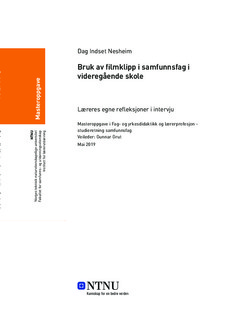| dc.contributor.advisor | Grut, Gunnar | |
| dc.contributor.author | Nesheim, Dag Indset | |
| dc.date.accessioned | 2019-08-23T14:08:41Z | |
| dc.date.available | 2019-08-23T14:08:41Z | |
| dc.date.issued | 2019 | |
| dc.identifier.uri | http://hdl.handle.net/11250/2610388 | |
| dc.description.abstract | Sammendrag
Utgangspunktet for dette forskningsprosjektet er det manglende fokuset på bruken av film i undervisningen i samfunnslærerutdanningen. Dagens ungdommer benytter seg i økende grad av digitale kilder for informasjon, deriblant digitale filmklipp. På tross av dette er lærere lite villig til å benytte de samme kildene for å trene opp elevenes ferdigheter til kritisk å vurdere det de møter på nett. Forskningsprosjektet ser derfor på bruken av filmklipp i videregående samfunnsfagundervisning, i den hensikt å komme fram til en undervisningspraksis. Problemstillingen er som følger: Hvorfor og hvordan bruke(s) filmklipp i samfunnsfagundervisningen på videregående trinn? Jeg har gjennom kvalitativ metode samlet inn informasjon om hvorfor og hvordan ni lærere i videregående skole bruker filmklipp når de underviser i samfunnsfag og andre nærliggende fag. På grunn av forskningsprosjektets eksplorative natur, har jeg benyttet halvplanlagte, formelle intervju, mens empirien er analysert med verktøy fra Grounded theory.
Oppgaven er inndelt i seks kapitler. Kapittel 1: Innledning forklarer bakgrunnen for valg av emne, presenterer problemstillingen og forskningsspørsmålene, og viser oppgavens struktur. I Kapittel 2: Forskningsstatus, avklares aktuelle begrep før tidligere forskning, relevant teori og oppgavens metode presenteres. Teorigrunnlaget for didaktisk bruk av film er ikke stort. Derfor knyttes teorien til en mer generell undervisningsmodell, MAKVISE, for å se om denne også er gyldig i bruk av filmklipp i videregående samfunnsfag. Kapittel 3: Empiri presenterer først hvordan film har blitt behandlet i læreplanverk. Deretter presenteres empirien oppdelt i fem deler, 3.2. Hvorfor brukes filmklipp i undervisningen, 3.3. Utdanning, 3.4.Hvordan brukes filmklipp i undervisningen, 3.5. Russells metoder og 3.6. Plattformer. I kapittel 4 og kapittel 5 fremlegges oppgavens drøfting. Kapittel 4: Empirisk drøfting svarer hovedsakelig på hvordan og hvorfor filmklipp brukes av informantene i samfunnsfagundervisningen på videregående trinn, i henhold til den empiriske forskningen, mens Kapittel 5: Konseptuell drøfting ser på hvorfor og hvordan det bør brukes. Forskningsprosjektets funn presenteres mot slutten av disse to kapitlene. Det sjette kapitlet er dermed kun en kort oppsummering av prosjektets og dets funn. Helt til slutt kommer bibliografien og vedlegg. | |
| dc.description.abstract | Abstract
This research project has come about because of the lack of focus on the use of film in the teacher education program for social science teachers. Today's youth are at an increasing pace using digital sources for information, including digital film clips. In spite of this, teachers are not willing to use the same sources to increase their students' skills in critically assessing what they encounter online. The research project therefore looks at the use of film clips in upper secondary social studies, for the purpose of arriving at a teaching practice. The problem is as follows: Why and how is film clips used in social studies in upper secondary education? And how should it be used? Through qualitative methods, I have gathered information about why and how nine teachers in high school use film clips when they teach social studies and other related subjects. Due to the explorative nature of the research project, I have used semi-planned, formal interviews, while the empirical data is analysed with tools from Grounded theory.
The paper is divided into six chapters. Chapter 1: Introduction explains the reason for choosing a topic, presents the problem and the research questions, and shows the structure of the assignment. In Chapter 2, relevant concepts are clarified before previous research, relevant theory and the method of the assignment are presented. The theory basis for didactic use of film is not great. Therefore, the theory is linked to a more general teaching model, MAKVISE, to see if this is also valid in the use of film clips in secondary social studies. Chapter 3 first presents how films have been treated in curricula. The empirical data is then presented in five parts, which look at why film clips are used in teaching, the teachers' education, how film clips are used in teaching, Russell's methods for teaching with film and which platforms the teachers use. In chapter 4 and chapter 5 the task's discussion is presented. Chapter 4 mainly deals with how and why film clips are used by the informants in social science education at upper secondary level, while Chapter 5 looks at why and how it should be used. The research project findings are presented towards the end of these two chapters. The sixth chapter is thus only a brief summary of the project and its findings. Finally, the bibliography and attachments are presented at the end. | |
| dc.language | nob | |
| dc.publisher | NTNU | |
| dc.title | Bruk av filmklipp i samfunnsfag i videregående skole | |
| dc.type | Master thesis | |
